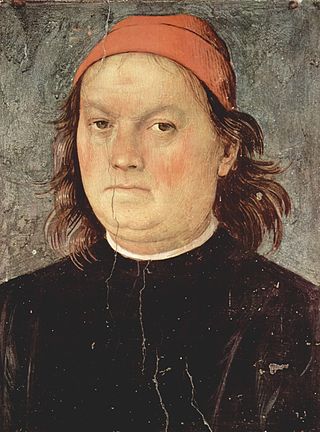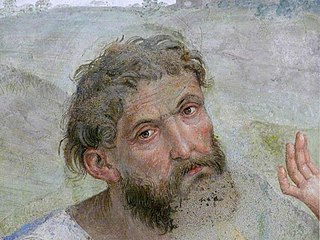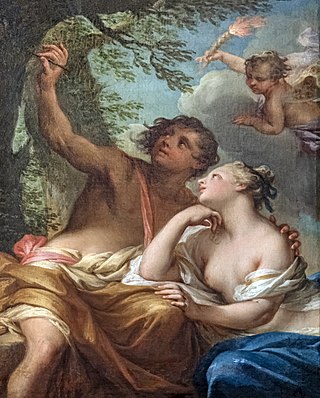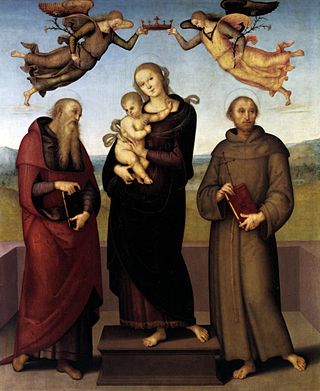
Filippino Lippi was an Italian painter working in Florence, Italy during the later years of the Early Renaissance and first few years of the High Renaissance.

The Adoration of the Magi or Adoration of the Kings or Visitation of the Wise Men is the name traditionally given to the subject in the Nativity of Jesus in art in which the three Magi, represented as kings, especially in the West, having found Jesus by following a star, lay before him gifts of gold, frankincense, and myrrh, and worship him. It is related in the Bible by Matthew 2:11: "On entering the house, they saw the child with Mary his mother; and they knelt down and paid him homage. Then, opening their treasure chests, they offered him gifts of gold, frankincense, and myrrh. And having been warned in a dream not to return to Herod, they left for their own country by another path".

Pietro Perugino, born Pietro Vannucci, was an Italian Renaissance painter of the Umbrian school, who developed some of the qualities that found classic expression in the High Renaissance. Raphael was his most famous pupil.

Lo Spagna, "the Spaniard" in Italian, was a painter of the High Renaissance, active in central Italy. His name was Giovanni di Pietro, but he was known as Lo Spagna because he was born in Spain. After Raphael, he was a main pupil and follower of the Umbrian painter Perugino, whose style his paintings develop. He should not be confused with Pietro di Giovanni D'Ambrogio of Siena.

Benvenuto Tisi was a Late-Renaissance-Mannerist Italian painter of the School of Ferrara. Garofalo's career began attached to the court of the Duke d'Este. His early works have been described as "idyllic", but they often conform to the elaborate conceits favored by the artistically refined Ferrarese court. His nickname, Garofalo, may derive from his habit of signing some works with a picture of a carnation.

The basilica diSan Pietro is a Catholic basilica and abbey in the Italian city of Perugia. Its bell tower, standing at 70 meters tall, is the tallest structure in Perugia and is one of the city's most significant symbols. It is an Italian national monument
Events from the year 1504 in art.

Giovanni Filippo Criscuolo was an Italian painter, active during the late-Renaissance period, mainly in Naples.
Giovanni Vincenzo Corso was an Italian painter of the Renaissance period. He was born in Naples. He was a pupil of Giovanni Antonio Amato and influenced by Pietro Perugino, Andrea Sabbatini, and Polidoro da Caravaggio, and subsequently went to Rome, where he assisted Perin del Vaga. Most of the works of this artist in the churches at Naples have been damaged and retouched. They include a Christ bearing his Cross for the church of San Domenico Maggiore, and an Adoration of the Magi for the church of San Lorenzo Maggiore. He died in Rome in 1545.
Pietro Ricchi was an Italian painter of the Baroque period, born in Lucca.

Andrea Casali was an Italian painter of the Rococo period. He was also an art dealer in England.
Tommaso Barnabei, also known as Maso Papacello, was an Italian painter of the Renaissance.

The Adoration of the Magi is a painting by the Italian Renaissance painter Pietro Perugino, housed in the Galleria Nazionale dell'Umbria of Perugia, Italy.

The Adoration of the Magi is a painting by the Italian Renaissance master Domenico Ghirlandaio, executed around 1485–1488 and housed in the Ospedale degli Innocenti gallery in Florence, Italy. The predella, painted by Bartolomeo di Giovanni, is in the same site.

Adoration of the Magi is a 1504 fresco by Perugino in the Oratorio di Santa Maria dei Bianchi in Città della Pieve. It shows the Adoration of the Magi, with an idealised view from Città della Pieve towards Lake Trasimene and Val di Chiana in the background. It is often compared to the Adoration of the Magi in the Sala delle Udienze del Collegio del Cambio in Perugia by Perugino and his studio, which includes areas argued by some art historians to have been painted by a young Raphael.

The Sant'Agostino Altarpiece is a painting by Perugino, produced in two stages between around 1502 and 1512 and then around 1513 to 1523. The altarpiece's 28, 29 or 30 panels were split up during the Napoleonic suppression of religious houses - most of its panels are now in the Galleria Nazionale dell'Umbria in Perugia. It is notable as the painter's last masterwork before he moved into his late phase producing more provincial commissions.

Madonna della Consolazione is an oil on panel painting by Perugino, datable ca. around 1496–1498. The work, completed in April 1498, was carried out in the Sala delle Udienze of the Collegio del Cambio. Since c. 1820 it is preserved in the National Gallery of Umbria in Perugia.
Madonna and Child with St Peter and St Paul is a c.1515 painting by Perugino or his studio, held in the Collegiata dei santi San Pietro e Paolo in Monteleone d'Orvieto. It shows the Madonna and Child between St Peter and Paul of Tarsus, with a semi-circular cymatium showing the Resurrection.

The Madonna of Loreto is a c.1507 oil on panel painting by Perugino, now in the National Gallery, London, which bought it in 1879. It shows the Madonna and Child flanked by Jerome (left) and Francis of Assisi (right). Two angels hover over Mary's head holding a crown. It reuses the low parapet from Madonna and Child with St Rose and St Catherine (1492) and probably also involved the master's studio assistants.














